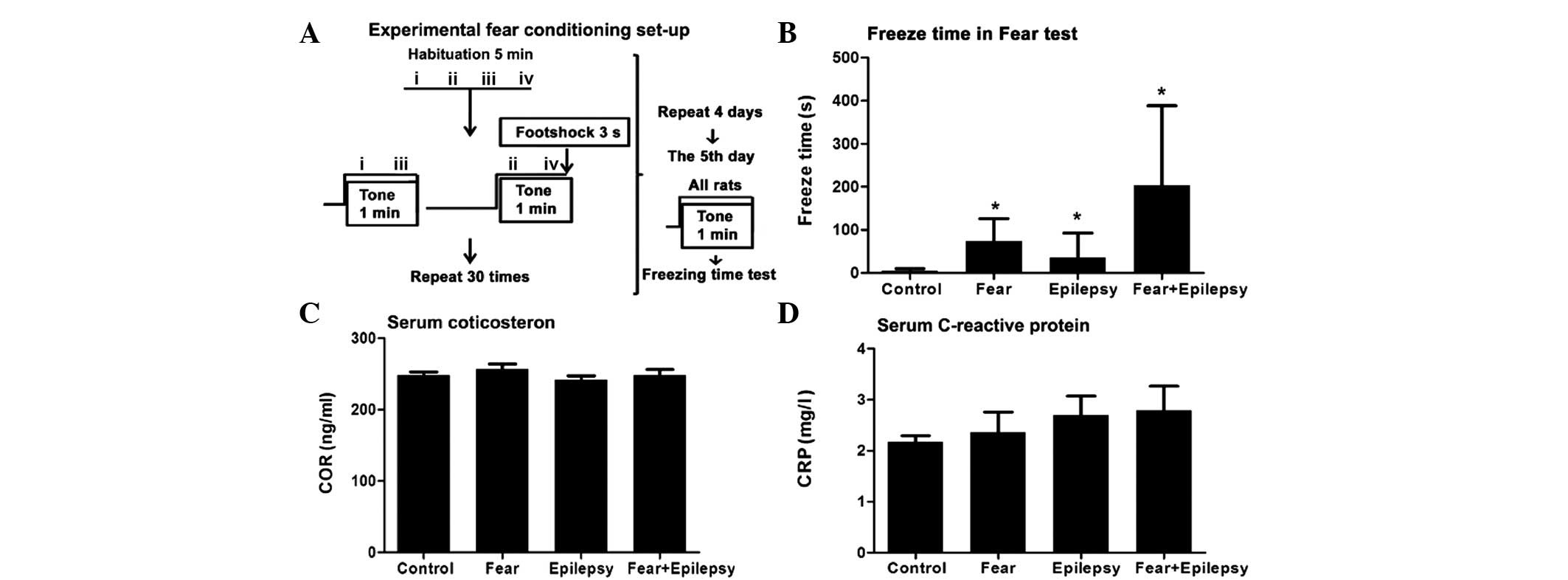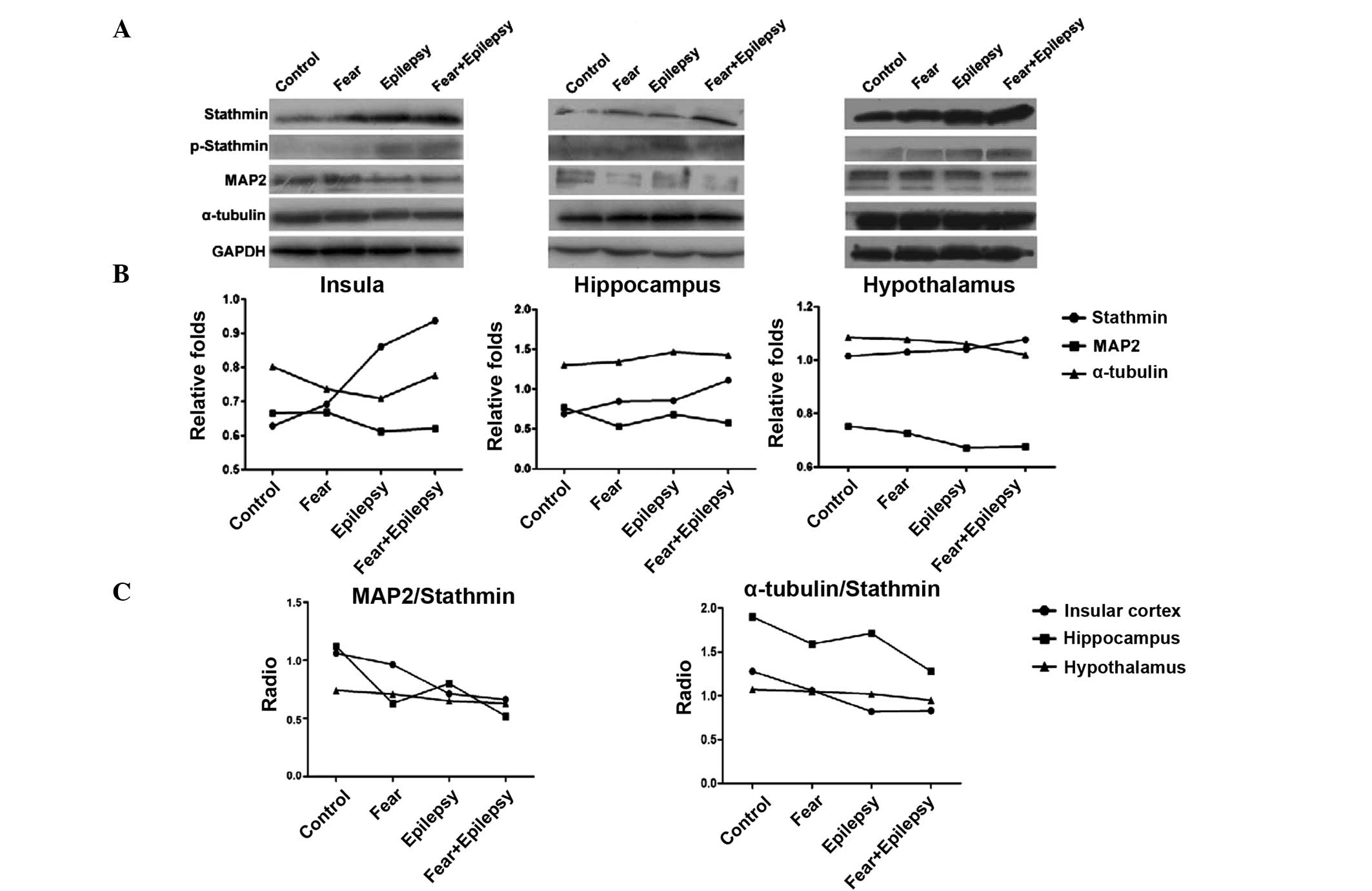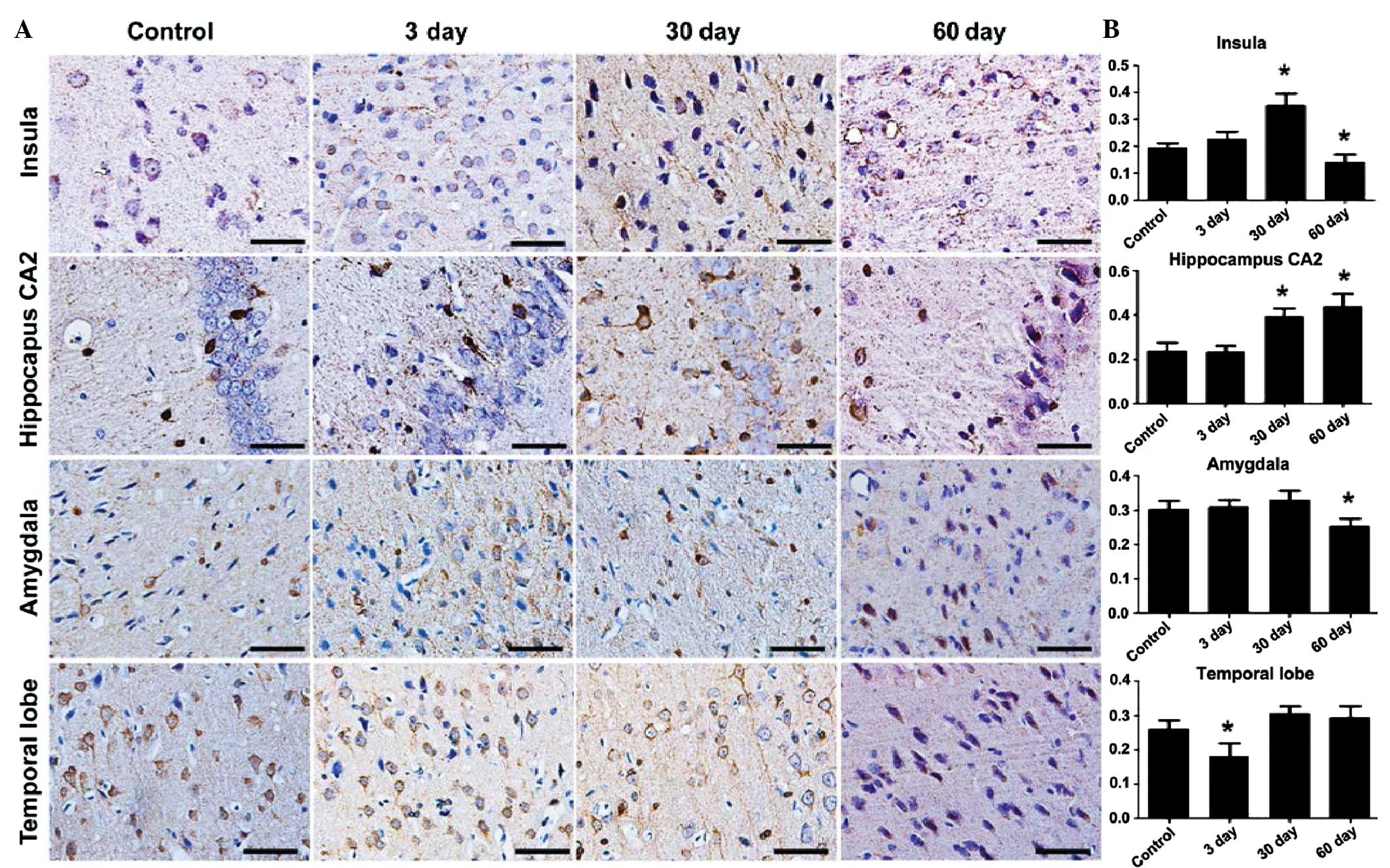Increased stathmin expression strengthens fear conditioning in epileptic rats
- Authors:
- Published online on: November 14, 2014 https://doi.org/10.3892/br.2014.386
- Pages: 28-32
Abstract
Introduction
The association between epilepsy and fear has attracted increasing attention alongside epilepsy research. Fear has been described as a crucial symptom of epilepsy, even in the oldest Chinese medical book. A large number of clinical cases of patients with temporal lobe epilepsy seizures often have inexplicable fear attack as the aura (1). Numerous patients reported the emotion of fear prior to seizures (2). Mesial temporal lobe epilepsy is commonly associated with ictal fear (3), and temporal lobectomy patients showed a general impairment in fear conditioning (4,5). However, the association between seizure-modulated fear and the underlying basics of neuronal mechanisms remains unclear.
Recent studies (6) identified stathmin as one of the key controlling molecules in learning and innate fear. Stathmin-knockout mice exhibit a decreased memory in amygdala-dependent fear conditioning and fail to recognize danger in innately aversive environments (7). The stathmin protein binds to tubulin and inhibits microtubule assembly and promotes microtubule catastrophes (8,9). Overexpression of stathmin can lead to disassembly of microtubules (10).
Therefore, stathmin is predicted to play a crucial role in associating the two processes; epilepsy seizures and fear conditioning. In the present study, the expression of stathmin in the epileptic rats was analyzed in detail with fear to confirm this hypothesis.
Materials and methods
Animals and epilepsy model
Adult male Sprague-Dawley rats (180–220 g) were used in the study. All the experimental procedures were approved by the Animal Research Committee of the Ningxia Medical University (Ningxia, China) and performed in accordance with the Chinese Animal Welfare Act for the use and care of laboratory animals. Rats were divided into four groups at random: Normal control (control), fear conditioning (fear), epilepsy (epilepsy) and epilepsy treated with fear groups (epilepsy + fear). The rats with epilepsy were triggered with pilocarpine and raised for 30 days after the epilepsy seizure. Each group comprised of six rats.
The epileptic model was established with LiCl/pilocarpine as previously described (10). The rats were injected intraperitoneally (IP) with LiCl (127 mg/kg) on day 1 and administered pilocarpine injection (30 mg/kg) 18–24 h later. Epileptic seizures of racine Ⅳ-V grade were chosen for the experiments. Epileptic rats were administered chloral hydrate (300 mg/kg) injection IP after 1 h of seizures to suppress the seizures. The normal control rats were administered the saline injection, respectively.
Fear conditioning and freezing time
The rats were placed in the conditioning chamber (23×23×35 cm) for 5 min before the loudspeaker stimulus. A sonic wave (1 min, 1,000 Hz, 75 Db) was delivered through the loudspeaker as the conditioned stimulus. Electrical foot shock (3 sec, 1 mA) stimulation occurred from the metal grid floor as the unconditioned stimulus. The context was a 1 min tone followed by the 3 sec foot shock, which was repeated 30 times (Fig. 1A). Following training in the chamber, the rats were returned to their home cages. The training was performed in 4 consecutive days. The rats of the fear and the epilepsy treated with fear groups underwent this training procedure. The control and the epilepsy groups had the same conditioned stimulus of the tone, but without the unconditioned electric stimulation at the foot shock.
Freezing time was used as an index of fear conditioning. Freezing was defined as immobility, excluding respiratory movements with a freezing posture. Rats remained still, sluggish, curled or crouched whilst breathing, and had a slight rocking motion. The total time of the freezing posture was called the freezing time and was measured starting from day 5 of training. The freezing time was measured immediately after the tone stimulation (without foot shock) and within 30 min. The behavioral activities were recorded by video.
Serum corticosterone (COR) and C-reactive protein (CRP) radioimmunoassay
The rats were anaesthetized and subsequentely decapitated to collect the whole blood with centrifuge tubes. Blood was incubated at 37̊C for 30 min. Serum was collected after 10 min centrifugation at 1,688 x g. Serum COR and CRP concentrations were measured by the radioimmunoassay kits, following the manufacturer's instructions. COR and hs-CRP radioimmunoassay kits were purchased from the Beijing Huaying Biotechnology Research Institute (Beijing, China). The radioimmunoassay was analyzed on the BN II Nephelometer (Dade Behring Marburg GmbH, Marburg, Germany) analyzer.
Brain tissue preparation, immunohistochemistry and western blotting
Brains were dissected and fixed routinely. A stainless steel rat brain matrix (175–300 g, coronal; RWD Life Science Co., Ltd., Shenzhen, China) was used to define the brain tissue blocks, including the hippocampus and insular cortex, respectively. A total of 15-µm coronal serial sections were prepared routinely. The boundary of the hippocampus and insular cortex was defined in accordance with the atlas of Paxinos and Watson (11). Ten sections, including the hippocampus or insular cortex, from each animal were chosen.
Immunohistochemistry was performed routinely. The stathmin protein 1 antibody (1:80; Proteintech, Inc., Chicago, IL, USA) and microtubule-associated protein (MAP2) antibodies (1:100; Bioworld, Visalia CA, USA) were used. The avidin-biotin kit (Zhongshan Golden Bridge Biotechnology Co., Ltd., Beijing, China) was used for the second antibody incubation and 3,3′-diaminobenzidine staining. All the sections were counterstained with hematoxylin. The immunohistochemistry-positivity of the images was assessed semi quantitatively by automatically measuring the optical densities.
Western blotting was performed routinely. Antibodies were used at the following concentrations: Stathmin 1 (1:300; cat no. ab47328); phosphorylated stathmin 1 (1:500; cat no. ab47398; Abcam, Cambridge, MA, USA); microtubule-associated protein (1:800; cat no. 17490-1-AP; Bioworld); α-tubulin (1:5,000; cat no. 66031-1-Ig Proteintech); GAPDH (1:5,000; cat no. TA-08; Bioss, Beijing, China); and horseradish peroxidase-conjugated goat anti-rabbit immunoglobulin G (cat no. ZB-2301; ZSGB-BIO, Beijing, China). Quantization of relative band densities was performed by scanning densitometry.
Statistical analysis
All the data were processed using SPSS 17.0 software (SPSS, Inc., Chicago, IL, USA). Mean ± standard deviation that the measurement data using one-way ANOVA; same object point in time measurement data using a repeated measures analysis of variance. P<0.05 was considered to indicate a statistically significant difference.
Results
Fear is strengthened following epilepsy
Rats (n=6) in the normal control exhibited an extremely short freezing time, from 2 to 14 sec, with an average of 5 sec. Whereas the epileptic rats (n=6, and epilepsy after 30 days) had a longer freezing time, from 10 to 152 sec, with an average of 36 sec, which was ~5–6-fold longer compared to the normal control (Fig. 1B).
Rats with fear training by tone and foot shock (fear) only (n=6) exhibited an increased freezing time immediately following the shock, from 15 to 152 sec, with an average of 74 sec. This was ~10–12-fold longer compared to the control and ~2-fold longer compared to the epilepsy group. Therefore, the contextual fear has occurred in these rats (F=4.521, P<0.05).
The rats of the epilepsy + fear (n=6) group had the longest freezing time among the four groups. The average freezing time was 203 sec, which was approximately three times higher compared to the fear group. As these rats have experienced epileptic seizures during the past 30 days, the increased freezing time revealed a significantly strengthened effect of epileptic seizures on the learned fear of the tone-shock contextual. These results indicate that these rats not only have the memory regarding the context in which they received the electrical stimulation, but have also developed a strong aversive response to the tone and the environment associated with a painful experience.
Systemic stress responses increase accompanied epilepsy and fear
Psychological processes, such as fear, are always accompanied with systemic stress responses. A systemic stress response includes objective signs of stress, such as high serum levels of adrenocorticotropic and cortisol, elevation of immunoreactions and an increase in arterial blood pressure (12). In the present study, the serum COR and inflammatory biomarker, CRP, were chosen as the biological indices of psychological stress caused by the fear.
The COR and CRP levels of the fear and the epilepsy + fear rats elevated when compared to the control. However, there was no statistical significance when compared to the control (Fig. 1C and D).
Epilepsy and fear increase the expression of stathmin
According to the results of the western blotting, as shown in Fig. 2, the expression of stathmin in the three areas of the brain increased in a similar sequence. The highest expression of stathmin was observed in the epilepsy + fear rats. Fear conditioning (the fear group) increased the expression of stathmin slightly, whereas the epilepsy + fear treatment increased it dramatically. The stathmin expression level of the epilepsy group was also significantly increased, more than that of the fear group, particularly in the insular cortex and hypothalamus, but less in the hippocampus (insula F=75.863, P<0.05; hippocampus F=36.698, P<0.05; and hypothalamus F=150.761, P<0.05).
Stathmin is a phospho-protein that binds to tubulin and regulates microtubule dynamics. The binding of stathmin to tubulin and its ability to disrupt the microtubules is modulated through its phosphorylation on multiple serine residues. These microtubule destabilizing activities are suppressed by phosphorylation of stathmin (9). Therefore, the expression levels of phosphorylated stathmin were examined by western blotting. The phosphorylated stathmin increased slightly in the epilepsy + fear conditioning rats, in all three areas of the brain. The increasing effects on phosphorylated stathmin were stronger in the epilepsy group compared to the fear group, suggesting that phosphorylated stathmin was more sensitive in the epileptic brain to the contextual stimulus of tone.
Western blotting analysis revealed that the expression of MAP2 decreased inversely with stathmin in the epilepsy and the fear groups in all three areas of the brain. The most significant decrease was observed in the epilepsy + fear group (Fig. 2). The expression of α-tubulin was not significantly changed in all the groups and in all three areas of the brain.
The microtubule stability was indicated by the ratio of MAP2 and α-tubulin/stathmin. In all three areas of the brain tested, epilepsy + fear had the lowest ratio, indicating that the microtubule stability was lowest. The most evident change of this ratio occurred in the insular cortex, instead of the hippocampus (Fig. 2).
Stathmin expression peaks at 30 days after epileptic seizures
To further analyze the variation of stathmin expression during the development of epilepsy, the immunohisotochemical patterns in the temporal cortex and the hippocampus were examined at 3, 30 and 60 days after the epileptic seizures. The stathmin expression started to increase at 3 days and reached its peak after 30 days of epilepsy in the local areas of the insular cortex. The reinforced stathmin expression in the dendrites was even more noticeable in the local areas of the insular, which was located at the IV layer of the cortex. Evident variation patterns were also observed in the hippocampus CA2 region, but not in the amygdale and temporal lobe cortex (Fig. 3). Stathmin expression declined to the normal control level in 60 days, in all the areas tested (insula F=52.018, P<0.05; hippocampus F=42.074, P<0.05; amygdala F=12.699, P<0.05; and temporal lobe F=21.469, P<0.05).
Discussion
Epileptic seizures can lead to psychological deficits, including learning and memory deficits, fear, language impairment and depression. In certain temporal lobe epileptic patients, intense ictal fear was the main feature of epileptic seizures (14). The present study confirmed that epilepsy can strongly aggravate or strengthen the fear conditioning and makes the epileptic rats more sensitive to the fear stimulation, as demonstrated by a longer freezing time.
Stathmin is essential for regulation of the innate and learned fear. Those rats with a longer freezing time exhibited a higher expression level of stathmin. Epilepsy alone, without the fear conditioning, has certain increasing effects on stathmin expression, which reached its peak at 30 days after seizure, particularly in the insular instead of the hippocampus.
Microtubules and cytoskeleton play crucial roles during the neuronal processes of epilepsy and fear (15). Stathmin strongly increases the minus end catastrophe frequency and induces rapid treadmilling of bovine brain microtubules (16). The MAP2 expression decreased inversely with the increase of stathmin. This result indicates that the microtubule stability plays a crucial role in the epilepsy associated fear conditioning.
The insular lobe has also been shown to generate interictal and ictal discharges in the majority of temporal lobe epileptic patients analyzed with depth electrodes positioned in this area (17). In the present study, the most evident changes of stathmin expression occurred in the insular cortex and the hippocampus, instead of the amygdale. This result suggests that the insular cortex may play a more important role in the correlation of fear and epilepsy.
In conclusion, epilepsy can strongly aggravate the sensation of fear, as exhibited by a longer freezing time. This is evidenced by an increase in stathmin expression and an inverse decrease of microtubule stability, particularly in the insular cortex.
Acknowledgements
The present study was supported by grants from the Chinese National 973 Projects (nos. 2011CB512115 and 2012CB722408) to Tao Sun, the National Natural Science Foundation of China (nos. 30960150 and 31260246) to Qikuan Hu, the Natural Science Foundation of Ningxia (no. NZ12172) to Linna Zhang and the Funds of Ningxia Medical University (no. XT200909) to Qikuan Hu.
References
|
Chiesa V, Gardella E, Tassi L, Canger R, Lo Russo G, Piazzini A, Turner K and Canevini MP: Age-related gender differences in reporting ictal fear: analysis of case histories and review of the literature. Epilepsia. 48:2361–2364. 2007.PubMed/NCBI | |
|
Ryan S and Räisänen U: ‘The brain is such a delicate thing’: an exploration of fear and seizures among young people with epilepsy. Chronic Illn. 8:214–224. 2012. View Article : Google Scholar | |
|
Reynders HJ, Broks P, Dickson JM, Lee CE and Turpin G: Investigation of social and emotion information processing in temporal lobe epilepsy with ictal fear. Epilepsy Behav. 7:419–429. 2005. View Article : Google Scholar : PubMed/NCBI | |
|
Weike AI, Hamm AO, Schupp HT, Runge U, Schroeder HW and Kessler C: Fear conditioning following unilateral temporal lobectomy: dissociation of conditioned startle potentiation and autonomic learning. J Neurosci. 25:11117–111124. 2005. View Article : Google Scholar | |
|
Hlobil U, Rathore C, Alexander A, Sarma S and Radhakrishnan K: Impaired facial emotion recognition in patients with mesial temporal lobe epilepsy associated with hippocampal sclerosis (MTLE-HS): Side and age at onset matters. Epilepsy Res. 80:150–157. 2008. View Article : Google Scholar : PubMed/NCBI | |
|
Zhang L.-Ν..LI H.-Υ..Tao H..HU Q.-Κ.: Expression of stathmin gene in brain of epilepsy rats. ShanDong Med. 41:24–28. 2012.(In Chinese). | |
|
Shumyatsky GP, Malleret G, Shin RM, Takizawa S, Tully K, Tsvetkov E, Zakharenko SS, Joseph J, Vronskaya S, Yin D, Schubart UK, Kandel ER and Bolshakov VY: Stathmin, a gene enriched in the amygdala, controls both learned and innate fear. Cell. 123:697–709. 2005. View Article : Google Scholar : PubMed/NCBI | |
|
Niethammer P, Bastiaens P and Karsenti E: Stathmin-tubulin interaction gradients in motile and mitotic cells. Science. 303:1862–1866. 2004. View Article : Google Scholar : PubMed/NCBI | |
|
Curmi PA, Gavet O, Charbaut E, Ozon S, Lachkar-Colmerauer S, Manceau V, Siavoshian S, Maucuer A and Sobel A: Stathmin and its phosphoprotein family: general properties, biochemical and functional interaction with tubulin. Cell Struct Funct. 24:345–357. 1999. View Article : Google Scholar : PubMed/NCBI | |
|
Cassimeris L: The oncoprotein 18/stathmin family of microtubule destabilizers. Curr Opin Cell Biol. 14:18–24. 2002. View Article : Google Scholar | |
|
Glien M, Brandt C, Potschka H, Voigt H, Ebert U and Löscher W: Repeated low-dose treatment of rats with pilocarpine: low mortality but high proportion of rats developing epilepsy. Epilepsy Res. 46:111–119. 2001. View Article : Google Scholar : PubMed/NCBI | |
|
Paxinos G and Watson C: The Rat brain in Stereotaxic Coordinates. 3rd. Academic Press; Sydney: pp. 51–73. 2007 | |
|
Dockray S and Steptoe A: Positive affect and psychobiological processes. Neurosci Biobehav Rev. 35:69–75. 2010. View Article : Google Scholar | |
|
Biraben A, Taussig D, Thomas P, Even C, Vignal JP, Scarabin JM and Chauvel P: Fear as the main feature of epileptic seizures. J Neurol Neurosurg Psychiatry. 70:186–191. 2001. View Article : Google Scholar : PubMed/NCBI | |
|
Gardiner J and Marc J: Disruption of normal cytoskeletal dynamics may play a key role in the pathogenesis of epilepsy. Neuroscientist. 16:28–39. 2010. View Article : Google Scholar : PubMed/NCBI | |
|
Manna T, Thrower D, Miller HP, Curmi P and Wilson L: Stathmin strongly increases the minus end catastrophe frequency and induces rapid treadmilling of bovine brain microtubules at steady state in vitro. J Biol Chem. 281:2071–2078. 2006. View Article : Google Scholar | |
|
Isnard J, Guénot M, Sindou M and Mauguière F: Clinical manifestations of insular lobe seizures: a stereo-electroencephalographic study. Epilepsia. 45:1079–1090. 2004. View Article : Google Scholar : PubMed/NCBI |












